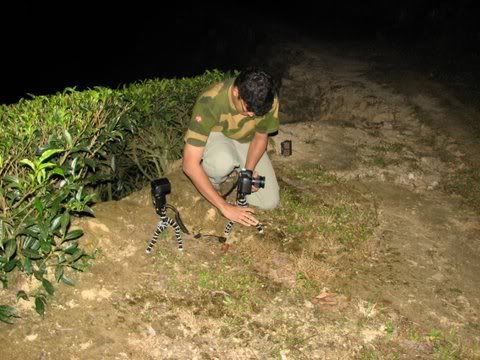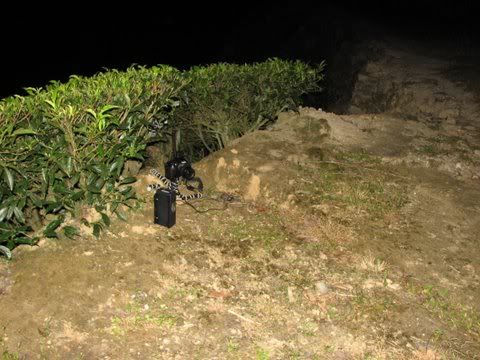The New Age Trapper
January 21, 2009
Time was, when trappers went around in raccoon caps and furs, and trapped animals for a living.
Today, the fur caps are no longer there…but trapping is still going on…in the nicest way imaginable.
At Valparai,
Here he is with the equipment:
 He fixed up the flash and the camera, and connected them:
He fixed up the flash and the camera, and connected them:
 He then tied up one part of the trap to the tea bush:
He then tied up one part of the trap to the tea bush:
 One part of the whole set up is here:
One part of the whole set up is here:
 And the other part is right opposite:
And the other part is right opposite:
 The trap is set up late at night, when there is very little chance of any human beings passing that way, and the equipment is collected very early in the morning. The images (if any) are then examined.
I realize that many of those who already know about camera trapping will find this a ridiculously simplistic explanation, but this was my first look at such equipment (I have spoken to Andre Pittet about camera traps but never actually seen one!) and I wanted to document it.
I know people like Nisarg, who has worked extensively with camera traps in Bandipur; and Pallavi, who analyses the images that the camera traps result in. I tend to think that theirs must be exciting work; but like all jobs, there must surely be the slog overs there, too. There would probably be many nights when either nothing results, or poor and blurry images are all that one gets. Kalyan, in his presentation at FOSS.in, talked about how an elephant once ...ate a camera trap!
The trap is set up late at night, when there is very little chance of any human beings passing that way, and the equipment is collected very early in the morning. The images (if any) are then examined.
I realize that many of those who already know about camera trapping will find this a ridiculously simplistic explanation, but this was my first look at such equipment (I have spoken to Andre Pittet about camera traps but never actually seen one!) and I wanted to document it.
I know people like Nisarg, who has worked extensively with camera traps in Bandipur; and Pallavi, who analyses the images that the camera traps result in. I tend to think that theirs must be exciting work; but like all jobs, there must surely be the slog overs there, too. There would probably be many nights when either nothing results, or poor and blurry images are all that one gets. Kalyan, in his presentation at FOSS.in, talked about how an elephant once ...ate a camera trap!
A camera trap seems to me to be the least intrusive way of documenting wildlife at night, and learning more about animals’ nocturnal behaviour as well. I’ll be waiting to see the entries in Kalyan’s “Camera Trap Diaries” !

